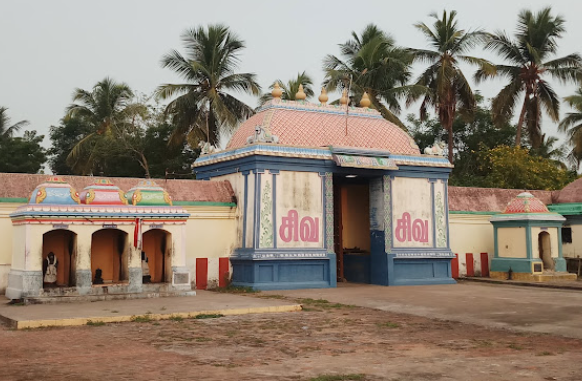Once, women from the celestial world visited Lord Shiva and Mother Parvathi at Mount Kailash, seeking a blessing for suitable marriages. Mother Parvathi looked to Lord Shiva for guidance. In response, Lord Shiva created a Shivalinga, installed it on the southern bank of the Cauvery River, and instructed the women to worship the Linga. They followed his instructions and were blessed with ideal matches. Even today, women come to this temple on new moon days to water the sacred tree and offer prayers to Lord Brahmapureeswarar for marriage blessings, believing that their wishes will be fulfilled by the next new moon day.
Sthala Puranam:
Once, unmarried celestial women approached Lord Shiva and Goddess Parvathi at Kailasam, seeking a boon to be married soon. While Parvathi did not respond, she looked towards Lord Shiva, who then established a Lingam on the banks of the River Cauvery (now the Vettaru) and advised the women to worship there. As a result, this temple became a prarthana sthalam (wish-fulfilling temple) for girls seeking marriage. Devotees visit the temple and water the sthala vriksham (sacred tree) on Amavasya (new moon day) to receive blessings for marriage.
Sage Gautama:Sage Gautama was appointed by Lord Shiva to take care of the Lingam that He had established. The sage diligently performed his duties while engaging in deep penance. Pleased with his devotion, Lord Shiva granted him a boon. Sage Gautama wished that after his lifetime, no one would see his mortal remains and requested to become the sthala vriksham (sacred tree) of the temple. When Gautama attained jeeva samadhi here, he merged with the sacred tree, known as Pon Arali (or Sevvarali), also called Karaveeram, which gave the place its name. The presiding deity, Lord Shiva, is thus called Karaveeranathar, and Sage Gautama has a separate shrine in the temple.
The main deity, Brahmapureeswarar, is named because Lord Brahma worshipped Lord Shiva here.
There is also a legend where Lord Shiva went for a stroll in the village, while Goddess Parvathi waited for His return in the maha mandapam of the temple. Both deities face east, and Parvathi stands to the right of Lord Shiva, symbolising their kalyana kolam (wedding form).
The Donkey's Penance: A fascinating story related to this temple tells of a donkey that performed intense penance, hoping to see Lord Shiva. When the donkey grew frustrated at not receiving the darshan, it decided to end its life and headed to Nagore to drown in the sea. Just as it was about to take the plunge, Lord Shiva called out and granted darshan to the donkey from this temple. Due to this event, there is no dwajasthambam (flag post) in front of the temple, and in ancient times, there were no buildings between the temple and Nagore, a distance of about 30 km. Some interpretations link the Sanskrit word "khara," meaning donkey, to the name Karaveeranathar.
Sambandar's Visit: When Saint Thirugnanasambandar arrived here late at night, he stayed at the temple and composed a pathigam (hymn) in praise of Lord Shiva the next morning. Each stanza of the pathigam emphasises that worshipping at this temple absolves devotees of their sins. It is believed that those who stay overnight at Karaveeram have their sins washed away and that those who worship here no longer have enemies.
Administration History :
The administration of Karaveeranathar Temple has evolved over centuries, traditionally overseen by local temple authorities and priests. During the Chola dynasty, the temple received royal patronage, which contributed to its maintenance and development. The temple was included in the management of the Hindu Religious and Charitable Endowments Department of the Government of Tamil Nadu. Over the years, various administrative changes aimed to preserve the temple's heritage and manage its rituals and festivals. Today, the temple continues to function under government oversight, ensuring that its historical and cultural significance is upheld.
